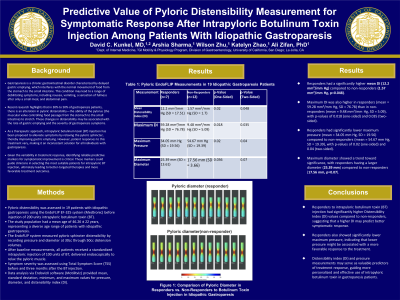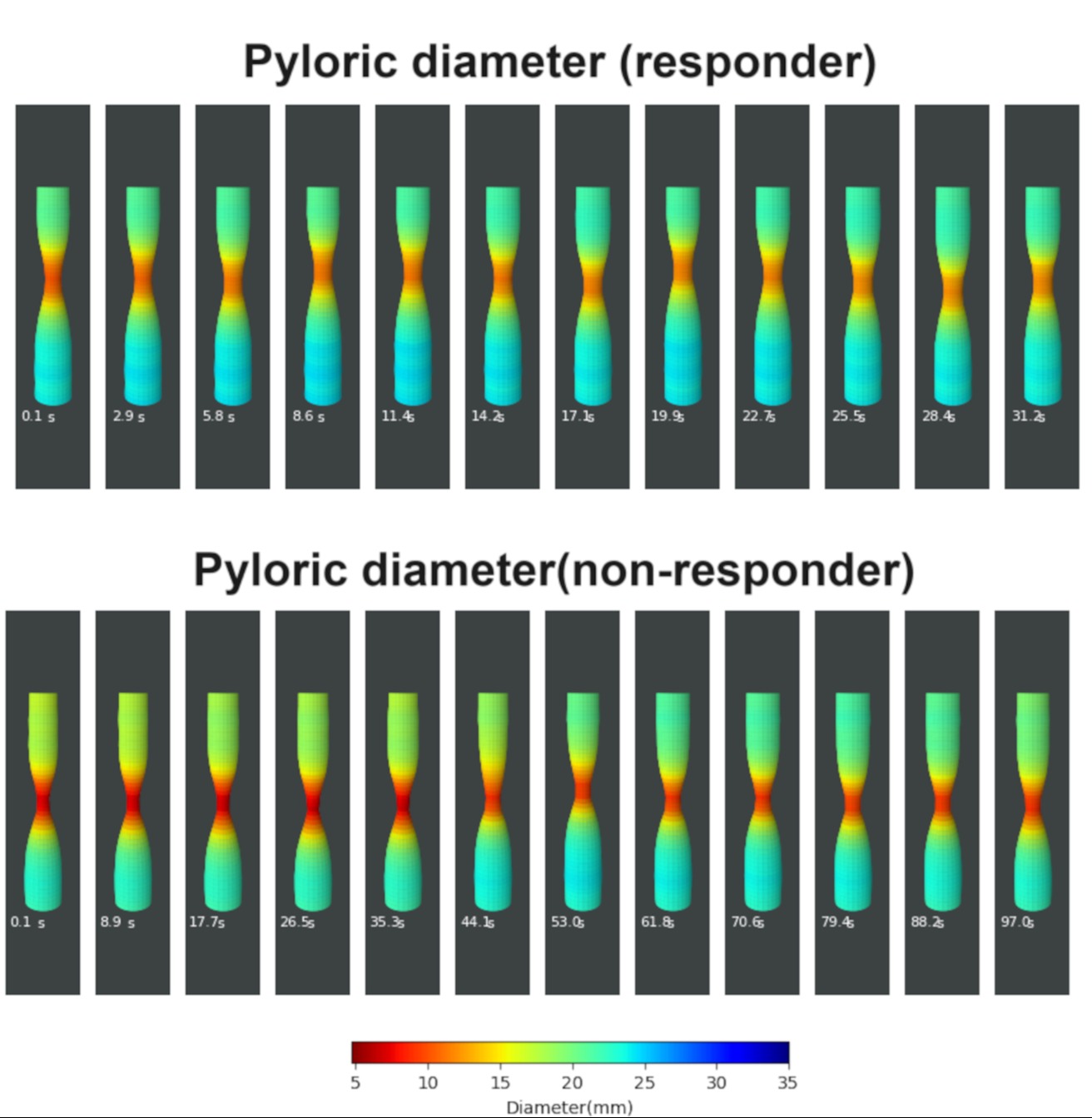Tuesday Poster Session
Category: Stomach
P5038 - Predictive Value of Pyloric Distensibility Measurement for Symptomatic Response After Intrapyloric Botulinum Toxin Injection Among Patients With Idiopathic Gastroparesis
Tuesday, October 29, 2024
10:30 AM - 4:00 PM ET
Location: Exhibit Hall E

Has Audio

David C. Kunkel, MD
University of California San Diego
La Jolla, CA
Presenting Author(s)
David C. Kunkel, MD1, Arshia Sharma, 1, Wilson Zhu, 1, Katelyn Zhao, 1, Ali Zifan, PhD2
1University of California San Diego, La Jolla, CA; 2UC San Diego, La Jolla, CA
Introduction: Gastroparesis is a chronic condition characterized by delayed gastric emptying, leading to symptoms such as nausea, vomiting, early satiety, and abdominal pain. Recent studies indicate that pyloric distensibility, or the ability of the pylorus to stretch, is altered in 30% to 50% of gastroparesis patients, correlating with gastric emptying rates and symptom severity. Intrapyloric botulinum toxin (BT) injection has been proposed to relax the pyloric sphincter and improve gastric emptying, although patient response varies. Identifying predictive markers for symptomatic response is essential to optimize patient selection and treatment outcomes.
Methods: Pyloric distensibility was measured in 19 idiopathic gastroparesis patients (mean age: 46.26±22 years) using the EndoFLIP system (Medtronic) post intrapyloric BT injection. Total symptomatic score (TSS) was assessed prospectively before and 3 months after BT injection. Data were analyzed using EndovizX software (Motilitviz, La Jolla) to extract pressure, diameter, and distensibility of the pyloric region from 30cc volume to 10-second point 50cc volume, including mean, standard deviation, minimum, and maximum values.
Results: Significant differences were observed between responders (n=7) and non-responders (n=12). Responders had a significantly higher mean distensibility index (DI) (mean DI = 12.2 mm²/mm Hg, SD = 17.51) compared to non-responders (mean DI = 1.57 mm²/mm Hg, SD = 1.7), with p-values of 0.024 (one-sided) and 0.048 (two-sided). Maximum DI was also higher in responders (mean = 59.28 mm²/mm Hg, SD = 76.78) vs. non-responders (mean = 9.48 mm²/mm Hg, SD = 5.09), with p-values of 0.018 (one-sided) and 0.035 (two-sided). Maximum pressure was significantly lower in responders (mean = 34.05 mm Hg, SD = 19.56) vs. non-responders (mean = 54.67 mm Hg, SD = 19.39), with p-values of 0.02 (one-sided) and 0.04 (two-sided). Maximum diameter showed a near-significant trend, with responders having a larger mean diameter (mean = 25.39 mm, SD = 13.61) vs. non-responders (mean = 17.56 mm, SD = 3.66), with p-values of 0.036 (one-sided) and 0.073 (two-sided).
Discussion: The significant differences in distensibility index (DI) between responders and non-responders suggest that DI could be a key predictor of symptomatic response to intrapyloric BT injection. Further research with larger sample sizes is needed to validate its role in personalized treatment strategies for gastroparesis.

Disclosures:
David C. Kunkel, MD1, Arshia Sharma, 1, Wilson Zhu, 1, Katelyn Zhao, 1, Ali Zifan, PhD2. P5038 - Predictive Value of Pyloric Distensibility Measurement for Symptomatic Response After Intrapyloric <i>Botulinum Toxin</i> Injection Among Patients With Idiopathic Gastroparesis, ACG 2024 Annual Scientific Meeting Abstracts. Philadelphia, PA: American College of Gastroenterology.
1University of California San Diego, La Jolla, CA; 2UC San Diego, La Jolla, CA
Introduction: Gastroparesis is a chronic condition characterized by delayed gastric emptying, leading to symptoms such as nausea, vomiting, early satiety, and abdominal pain. Recent studies indicate that pyloric distensibility, or the ability of the pylorus to stretch, is altered in 30% to 50% of gastroparesis patients, correlating with gastric emptying rates and symptom severity. Intrapyloric botulinum toxin (BT) injection has been proposed to relax the pyloric sphincter and improve gastric emptying, although patient response varies. Identifying predictive markers for symptomatic response is essential to optimize patient selection and treatment outcomes.
Methods: Pyloric distensibility was measured in 19 idiopathic gastroparesis patients (mean age: 46.26±22 years) using the EndoFLIP system (Medtronic) post intrapyloric BT injection. Total symptomatic score (TSS) was assessed prospectively before and 3 months after BT injection. Data were analyzed using EndovizX software (Motilitviz, La Jolla) to extract pressure, diameter, and distensibility of the pyloric region from 30cc volume to 10-second point 50cc volume, including mean, standard deviation, minimum, and maximum values.
Results: Significant differences were observed between responders (n=7) and non-responders (n=12). Responders had a significantly higher mean distensibility index (DI) (mean DI = 12.2 mm²/mm Hg, SD = 17.51) compared to non-responders (mean DI = 1.57 mm²/mm Hg, SD = 1.7), with p-values of 0.024 (one-sided) and 0.048 (two-sided). Maximum DI was also higher in responders (mean = 59.28 mm²/mm Hg, SD = 76.78) vs. non-responders (mean = 9.48 mm²/mm Hg, SD = 5.09), with p-values of 0.018 (one-sided) and 0.035 (two-sided). Maximum pressure was significantly lower in responders (mean = 34.05 mm Hg, SD = 19.56) vs. non-responders (mean = 54.67 mm Hg, SD = 19.39), with p-values of 0.02 (one-sided) and 0.04 (two-sided). Maximum diameter showed a near-significant trend, with responders having a larger mean diameter (mean = 25.39 mm, SD = 13.61) vs. non-responders (mean = 17.56 mm, SD = 3.66), with p-values of 0.036 (one-sided) and 0.073 (two-sided).
Discussion: The significant differences in distensibility index (DI) between responders and non-responders suggest that DI could be a key predictor of symptomatic response to intrapyloric BT injection. Further research with larger sample sizes is needed to validate its role in personalized treatment strategies for gastroparesis.

Figure: Figure 1. Pyloric Diameter in Idiopathic Gastroparesis Patients: Responders vs. Non-Responders to Pyloric Botox Injection
Disclosures:
David Kunkel: Evoke Pharma – Consultant. Phathom Pharmaceuticals – Speakers Bureau. Regeneron Pharmaceuticals – Speakers Bureau. Sanofi – Speakers Bureau. Vanda Pharmaceuticals – Grant/Research Support.
Arshia Sharma indicated no relevant financial relationships.
Wilson Zhu indicated no relevant financial relationships.
Katelyn Zhao indicated no relevant financial relationships.
Ali Zifan indicated no relevant financial relationships.
David C. Kunkel, MD1, Arshia Sharma, 1, Wilson Zhu, 1, Katelyn Zhao, 1, Ali Zifan, PhD2. P5038 - Predictive Value of Pyloric Distensibility Measurement for Symptomatic Response After Intrapyloric <i>Botulinum Toxin</i> Injection Among Patients With Idiopathic Gastroparesis, ACG 2024 Annual Scientific Meeting Abstracts. Philadelphia, PA: American College of Gastroenterology.
